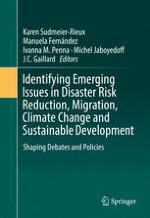2017 | OriginalPaper | Buchkapitel
7. The Necessity of Early Warning Articulated Systems (EWASs): Critical Issues Beyond Response
verfasst von : Irasema Alcántara-Ayala, Anthony Oliver-Smith
Erschienen in: Identifying Emerging Issues in Disaster Risk Reduction, Migration, Climate Change and Sustainable Development
Aktivieren Sie unsere intelligente Suche, um passende Fachinhalte oder Patente zu finden.
Wählen Sie Textabschnitte aus um mit Künstlicher Intelligenz passenden Patente zu finden. powered by
Markieren Sie Textabschnitte, um KI-gestützt weitere passende Inhalte zu finden. powered by
